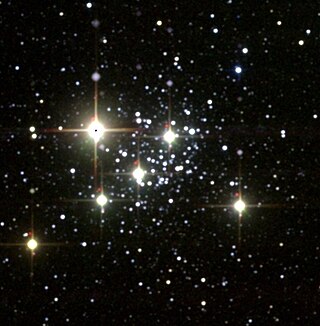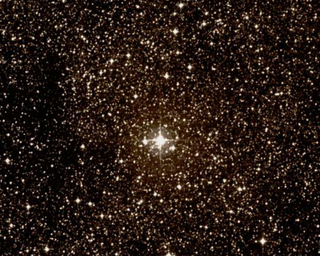Notes
- ↑ The radius is calculated with the Stefan-Boltzmann law, using the bolometric luminosity and effective temperature of WOH S279:
This article is being considered for deletion in accordance with Wikipedia's deletion policy. Please share your thoughts on the matter at this article's deletion discussion page. |
| Observation data Epoch J2000 Equinox | |
|---|---|
| Constellation | Dorado (LMC) |
| Right ascension | 05h 26m 01.1049s [1] |
| Declination | −66° 16′ 19.058″ [1] |
| Apparent magnitude (V) | 12.515 [2] |
| Characteristics | |
| Evolutionary stage | Red supergiant |
| Spectral type | M [3] |
| Apparent magnitude (B) | 14.205 [2] |
| Apparent magnitude (G) | 11.8867 [1] |
| Apparent magnitude (J) | 8.990 [2] |
| Apparent magnitude (H) | 8.103 [2] |
| Apparent magnitude (K) | 7.748 [2] |
| Astrometry | |
| Radial velocity (Rv) | 304.84 ± 0.30 [1] km/s |
| Proper motion (μ) | RA: 1.635 [1] mas/yr Dec.: 0.369 [1] mas/yr |
| Details | |
| Radius | 1,298 [4] [lower-alpha 1] R☉ |
| Luminosity | 228,000 [4] L☉ |
| Surface gravity (log g) | +0.0 [4] cgs |
| Temperature | 3,500 [4] K |
| Other designations | |
WOH S279, 2MASS J05260108-6616191, MSX LMC 844, SP77 44-19, NGC 1948 WBT 2215 | |
| Database references | |
| SIMBAD | data |
WOH S279 is a red supergiant located in the constellation of Dorado. [3] It is currently among the largest known stars with an radius of about 1,300 solar radii. If placed at the center of the solar system, its photosphere would engulf the orbit of Jupiter. [4]

ο Tauri, Latinized as Omicron Tauri, is a binary star system in the constellation Taurus, near the constellation border with Cetus. It has a yellow hue and is visible to the naked eye with an apparent visual magnitude of 3.61. It is approximately 191 light years from the Sun based on parallax, but is drifting closer with a radial velocity of −20 km/s. As the westernmost bright point of light in Taurus, this system has the Flamsteed designation 1 Tauri; Omicron Tauri is the Bayer designation.
22 Andromedae, abbreviated 22 And, is a single star in the constellation Andromeda. 22 Andromedae is the Flamsteed designation. It is visible to the naked eye with an apparent visual magnitude of 5.04. The distance to 22 And can be estimated from its annual parallax shift of just 2.2 mas, which shows it to be around 1,500 light years away. It is moving closer to the Earth with a heliocentric radial velocity of −8.2 km/s.
KW Sagittarii is a red supergiant, located approximately 1,900 parsecs away from the Sun in the direction of the constellation Sagittarius. It is one of the largest-known stars. If placed at the center of the Solar System, the star's surface would engulf Mars.

MY Cephei is a red supergiant located in open cluster NGC 7419 in the constellation of Cepheus. It is a semiregular variable star with a maximum brightness of magnitude 14.4 and a minimum of magnitude 15.5.

WOH G64 is an unusual red supergiant (RSG) star in the Large Magellanic Cloud (LMC) satellite galaxy in the southern constellation of Dorado. It is one of the largest known stars, being described as possibly being the largest star known. It is also one of the most luminous and massive red supergiants, with a radius calculated to be around 1,540 times that of the Sun (R☉) and a luminosity around 282,000 times the solar luminosity (L☉).
GJ 3379 is the nearest star in the Orion constellation, located at a distance of 17 light years from the Sun based on parallax. It is a single star with an apparent visual magnitude of +11.31 and an absolute magnitude of +12.71, therefore, the star is not visible with the naked eye. It is positioned in the upper left part of the Orion constellation, to the SSE of Betelgeuse. This star is drifting further away with a radial velocity of +30.0 kilometers per second. In the past, this star had a relatively close encounter with the Solar System. Some 161,000±6,000 years ago, it achieved a minimum distance of 4.08 ± 0.20 ly (1.25 ± 0.06 pc).

V602 Carinae is a red supergiant and variable star of spectral type of M3 in the constellation Carina. It is one of largest known stars.

20 Puppis is a solitary star in the southern constellation of Puppis. It is visible to the naked eye as a faint, yellow-hued star with an apparent visual magnitude of 4.99. The star lies approximately 990 light years away from the Sun based on parallax. It is receding from the Earth with a heliocentric radial velocity of +16.8 km/s.

V1073 Scorpii is a variable star in the constellation Scorpius. It has a non-Greek Bayer designation of k Scorpii. The star has a blue-white hue and is visible to the naked eye with an apparent visual magnitude that fluctuates around +4.87. Parallax measurements yield a distance estimate of approximately 2,920 ly (896 pc) from the Sun, and it is drifting further away with a radial velocity of +7 km/s. It has an absolute magnitude of −6.8

EV Carinae is a red supergiant and pulsating variable star of spectral type M4Ia in the constellation Carina. It is a semiregular variable star with its apparent magnitude varying between 7.4 and 9.0 in the visible band, making it only seen by binoculars or a telescope. Various periods have been identified, but the dominant one is around 347 days. It is an MK spectral standard star for the class M4.5Ia.

RW Cygni is a semiregular variable star in the constellation Cygnus, about a degree east of 2nd magnitude γ Cygni. Its apparent magnitude varies between 8.05 and 9.70 and its spectral type between M3 and M4.

BO Carinae, also known as HD 93420, is an irregular variable star in the constellation Carina.

HD 143183 is a red supergiant variable star of spectral type M3Ia in constellation Norma. It is a member of the Norma OB1 association, at a distance of about 2 kiloparsecs. It is one of the most luminous red supergiants with a luminosity over 100,000 times greater than the Sun (L☉), and is as well one of the largest stars with a radius more than a thousand times that of the Sun (R☉). Older studies frequently calculated higher luminosities and radii. It has an estimated mass loss rate of 5×10−5 M☉ per year and has been once described as a cool hypergiant. It is surrounded by a dozen early-type stars and a circumstellar nebula which extends 0.12 parsecs (0.39 ly).

HV 888, also known as WOH S140, is a red supergiant (RSG) star located in the Large Magellanic Cloud. It is among the largest known stars, with estimates of its radius ranging from 765 R☉ to over 1,700 R☉, and is also one of the most luminous of its type with a range of nearly 300,000 to over 500,000 times that of the Sun (L☉). The effective temperature is estimated to be around 3,500 K. If placed at the center of the Solar System, its photosphere would engulf the orbit of Jupiter and possibly even Saturn.

Westerlund 1-20 (abbreviated to Wd 1-20 or just W20) is a red supergiant (RSG) located in the Westerlund 1 super star cluster. Its radius was calculated to be around 965 solar radii (6.72 × 108 km, 4.48 au), making it one of the largest stars discovered so far. This corresponds to a volume 899 million times bigger than the Sun. If placed at the center of the Solar System, the photosphere of Westerlund 1-20 would almost reach the orbit of Jupiter.
WOH S281(IRAS 05261-6614) is a red supergiant located in the constellation of Dorado. It is currently among the largest known stars with a radius of over 1,300 solar radii. If placed at the center of the solar system, its photosphere would engulf the orbit of Jupiter.
SP77 46-44 is a red supergiant star found in the Large Magellanic Cloud in the constellation of Dorado. It is one of the largest stars discovered, with a radius over 1,200 solar radii. If placed in the Solar System, its photosphere would engulf the orbit of Jupiter.

IRAS 18357–0604 is a yellow hypergiant (YHG) star located in the constellation of Scutum, estimated to be about 19,600 light years, or 6,000 parsecs, away. IRAS 18357–0604 is remarkably similar to IRC +10420, another yellow hypergiant in the constellation of Aquila.

WOH S264 is a large, highly luminous red supergiant star in the Large Magellanic Cloud.

V1027 Cygni is a luminous yellow supergiant star located in the constellation of Cygnus, about 14,000 light years away. For a time, it was thought that it could be a low-mass post-AGB star, however recent parallax measurements published in Gaia DR3 have shown this to likely not be the case, and instead it is likely a massive yellow supergiant star.